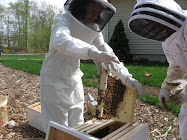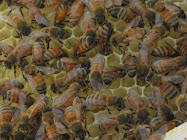
I have been to China, numerous times on business. What an amazing country and culture. Victor was a history major with a concentration in Chinese and Russian history, so it was particularly exciting to have to opportunity to travel there with him. I have read tons of Chinese non-fiction and fiction alike, and as Victor would say (and now I tend to agree) most of them have a similar theme -- a difficult but culturally rich life. Even their effort to squash their past culture during the Cultural Revolution made a very definite mark on their culture. Culture will be. Some of the books I've read and enjoyed are: Wild Swans, by Jung Chang (a non-fiction book following 3 generations of Chinese women, that is banned in China), the classic fictional novel The Good Earth, by Pearl S. Buck, and Snow Flower and the Secret Fan, by Lisa See.

Victor is big on experiencing the true culture of a place, so even though we were there on business, when we went out to dinner we asked to go to a "local" place. Most of the places we went to were very nice (as we were led there by folks from the hotel, and they would consider sending a foreigner to a local "joint", like sending an honored guest into the unfinished basement of an antique New England home to eat dinner off the floor), but I can tell you that no one in most of the places could speak English outside of "hello", "bye-bye" and "thank-you". It was fabulous. We meandered through side streets, many of which were slotted to be torn down to "redo" the look of Beijing before the Olympics. Many of the antique commune homes were torn down. Horrible. To me, the food in China was incredible. Simple really. Now, there were certainly some things that I stayed away from like duck-tongue, and the bugs. But, bugs aside, the food was fresh, simple and healthy. Nothing like the glopped up stuff you find in Chinese American Restaurants. (Even Chinese folks we talked to there said that the only Chinese food they would eat when coming to the United States was in New York City's Chinatown. (They didn't travel to Boston or San Francisco during that trip.)) Most things are steamed, or braised quickly in a wok with lots of peanut oil or sesame oil and garlic.

Fried Rice is really the perfect thing for frugal eating. You can make it as simple or as complicated as you like depending on what you have on hand and how much time you have to spend. Let me preface this by saying that I've never seen anyone make this. I really just invented it myself trying to achieve what I'd tasted over in China and then added in some of my own accents. One of the very simple versions of rice with vegetables that I had while in China was entirely steamed, including the egg. I'm not sure how they do that. But, they pulled it out of the rice cooker with simple white rice, peas, carrots and egg. That's it. Just a little salt in the water maybe. Cooking with brown rice (which you never see over there) would be trickier because the cooking time is about double and I would imagine that all of your vegetables would be mush! And, opening a rice cooker or pan with rice cooking half way through is a major faux pas, right? Anyway, back to pan fried rice . . .
The great thing about fried rice is that it's a one pot meal, and you use anything that you have on hand. As a gardener, it's great because you just meander outside and pick a few random things and head into the kitchen! I've even added kale into my fried rice! Why not?
First: Make your rice with a little salt. The real way to make fried rice apparently is with yesterday's rice. Because it will have dried out a little bit, and this prevents your fried rice from becoming clumping and mushy. If you don't generally eat rice two nights in a row, like us, just be sure not to overcook it. Brown rice is a particular challenge, but it is healthier!
While your rice is cooking, chop up up your vegetables. Garlic and/or onions are a must. Then, the rest is up to what you have on hand. If you want to be fancy, you could add some grated fresh ginger root, cilantro and green onion. Chop your vegetables small and thin. You want them to fry up quickly in your pan or wok.
If you'd like to have some meat, fry that up in your pan first. I've used hamburger just because we have that on hand from a local farmer, but that's hardly traditional. You could use pork, or shrimp. More often than not, I go vegetarian with a little egg thrown in for our protein (also from a local farm). If you are adding meat / fish, fry that up in a little sesame, peanut or olive oil, with a little salt and set it aside.
Throw a little sesame or peanut oil (1-2 T) and salt into a hot wok or pan and fry your vegetables until they are done to your liking. If your rice isn't done at this point, wait until it is.
Then, scramble a few eggs (1-3 depending on how much you're cooking and how much egg you like in your fried rice) in a bowl. Although a few recipes I read called for the egg to be fried separately like the meat, I just do it here for one less step. Make sure your pan is hot. Push your vegetables to the side of the pan, add 1 more tablespoon of the oil of your choice in the center and then pour the eggs on top. Let them set for a bit, then stir a little, and repeat until they are no longer runny. You want them to be small little bits of egg, not chunks like you'd get at the diner.
Throw your fried (browned) meat back in the pan, if you're using it.
Add your rice into the hot pan. Don't over stir. Once you mix in your rice, let it sit a bit then sort-of flip the whole lot over in sections. This is a fast operation. Drizzle a little soy sauce in there -- and your done!
Great things to put in your fried rice:
Well, rice.
Egg
Tofu
Garlic
Onion
Red, orange or yellow bell peppers
Peas
Carrots
Broccoli - chopped very small please!
Shrimp, Ground Pork
Ginger - grated
Cilantro - chopped, added at the end would be best
Bok Choy
I've even used green beans, sliced very thin.































No comments:
Post a Comment